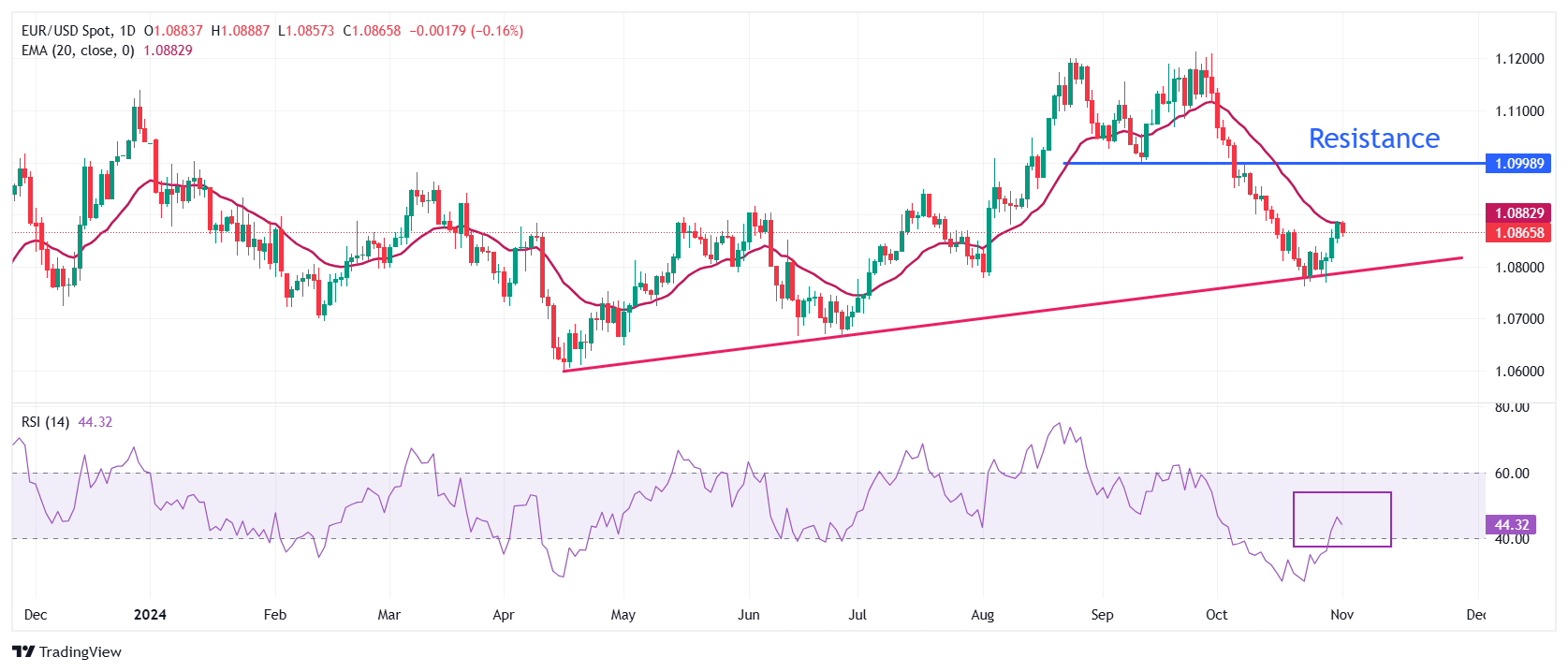EUR/USD retreats in the aftermath of US NFP data
- EUR/USD surrenders US NFP-inspired gains as the US Dollar bounces back.
- The US presidential election could potentially inject volatility into the major pair as a Trump win could hurt the Eurozone’s export sector.
- Market expectations for large rate cuts from the ECB in December have diminished amid a pickup in inflation and higher growth.
EUR/USD gives up gains after facing selling pressure near the key resistance of 1.0900 in North American trading hours on Friday. The major currency pair drops as the US Dollar (USD) bounces back strongly in the aftermath of the United States (US) Nonfarm Payrolls (NFP) data for October. Initial reaction from the US Dollar was negative, however, it rebounded strongly, with the US Dollar Index (DXY) returning back above 104.00.
The report showed that the economy added 12K fresh payrolls, significantly lower than estimates of 113K and the former release of 223K, downwardly revised from 254K in September. The Unemployment Rate remained steady at 4.1%, as expected.
The NFP report indicated that payroll employment estimates in some industries were affected by the hurricanes, which were identified on Florida’s Gulf Coast on September 26, 2024, and then tracked north into several other states. The Bureau of Labor Statistics (BLS) clarified that it is not possible to quantify the net effect on the over-the-month change in national employment, hours, or earnings estimates because the establishment survey is not designed to isolate effects from extreme weather events. However, the agency has said that it will release the state estimates of employment and unemployment for October on November 19, 2024.
Average Hourly Earnings data for October, a key measure of wage growth, rose expectedly by 4% on the year. Month-on-month wage growth measure rose by 0.4%, faster than estimates and the former release of 0.3%.
Meanwhile, the ISM Manufacturing Purchasing Managers’ Index (PMI) data surprisingly declined at a faster pace in October. The ISM Manufacturing PMI came in at 46.5, lower from 47.2 in September. Economists expected the factory activity to have improved to 47.6.
Going forward, investors will shift focus to the Federal Reserve (Fed) policy meeting on Thursday. According to the CME FedWatch too, traders are fully pricing in a 25 basis points (bps) rate cut, which will push interest rates lower to 4.50%-4.75%.
Daily digest market movers: EUR/USD retreats despite Euro's outperformance
- EUR/USD falls on the US Dollar's recovery. However, the Euro’s (EUR) strong performance against its peers. Faster-than-expected Eurozone Gross Domestic Product (GDP) growth in the third quarter of the year and hotter-than-forecasted inflation have forced traders to reassess bets supporting European Central Bank (ECB) larger-than-usual rate cut bets for the December policy meeting, a scenario that strengthens the Euro.
- Eurostat showed on Wednesday that the Eurozone economy expanded by 0.9% compared to the same quarter of the preceding year, accelerating from the 0.6% growth in the previous quarter, mainly due to a surprise performance of the German economy, according to flash estimates. This has diminished the immediate risks of an economic downturn, although the outlook remains uncertain ahead of the US presidential election, which will take place on Tuesday.
- Eurozone exports are expected to be hit if former President Donald Trump wins against current Vice President Kamala Harris. Trump has vowed for a universal tariff of 10% on all nations – except China, which is expected to face much higher tariffs – to boost in-house manufacturing capabilities.
- Another factor supporting the EUR is the recent inflation uptick in the Eurozone. The preliminary Harmonized Index of Consumer Prices (HICP) accelerated more than expected to 2% in October from 1.7% in September.
Technical Analysis: EUR/USD faces pressure near 20-day EMA
EUR/USD drops after posting a fresh two-week high around 1.0900 on Thursday. The major currency pair faces pressure near the 20-day Exponential Moving Average (EMA), which trades at around 1.0900. EUR/USD had previously rebounded sharply after gaining a firm footing near the upward-sloping trendline around 1.0750, which is plotted from the April 16 low at around 1.0600.
The 14-day Relative Strength Index (RSI) climbs to near 42.00 after staying in the 20.00-40.00 range for almost a month, suggesting that the bearish momentum is waning.
Looking up, the shared currency pair could rise to near the September 11 low around 1.1000. On the downside, the October 23 low of 1.0760 will be the key support area.
Fed FAQs
Monetary policy in the US is shaped by the Federal Reserve (Fed). The Fed has two mandates: to achieve price stability and foster full employment. Its primary tool to achieve these goals is by adjusting interest rates. When prices are rising too quickly and inflation is above the Fed’s 2% target, it raises interest rates, increasing borrowing costs throughout the economy. This results in a stronger US Dollar (USD) as it makes the US a more attractive place for international investors to park their money. When inflation falls below 2% or the Unemployment Rate is too high, the Fed may lower interest rates to encourage borrowing, which weighs on the Greenback.
The Federal Reserve (Fed) holds eight policy meetings a year, where the Federal Open Market Committee (FOMC) assesses economic conditions and makes monetary policy decisions. The FOMC is attended by twelve Fed officials – the seven members of the Board of Governors, the president of the Federal Reserve Bank of New York, and four of the remaining eleven regional Reserve Bank presidents, who serve one-year terms on a rotating basis.
In extreme situations, the Federal Reserve may resort to a policy named Quantitative Easing (QE). QE is the process by which the Fed substantially increases the flow of credit in a stuck financial system. It is a non-standard policy measure used during crises or when inflation is extremely low. It was the Fed’s weapon of choice during the Great Financial Crisis in 2008. It involves the Fed printing more Dollars and using them to buy high grade bonds from financial institutions. QE usually weakens the US Dollar.
Quantitative tightening (QT) is the reverse process of QE, whereby the Federal Reserve stops buying bonds from financial institutions and does not reinvest the principal from the bonds it holds maturing, to purchase new bonds. It is usually positive for the value of the US Dollar.
Forex News
Keep up with the financial markets, know what's happening and what is affecting the markets with our latest market updates. Analyze market movers, trends and build your trading strategies accordingly.















